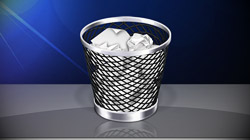Trash won’t empty? The ultimate guide to deleting stubborn files

Mac
OS X occasionally gets hung up on stubborn files and refuses to easily
delete them. If you can’t empty your Mac’s Trash, try some of these
techniques to get rid of those nasty errors and clear out the junk.
As a Mac user, you’ve probably found yourself in a situation where
you needed to force empty the Trash. Perhaps a message like “You do not
have sufficient privileges” or “Error code -8003″ kept popping up. In
many (but not all) cases, troublesome files reside on an external volume
or drive. Manually deleting Time Machine backups via Finder – which is a
big no-no – commonly triggers these problems, for example. Other times,
files on the main boot drive are in use by running applications and
cannot be removed. There’s no shortage of possible scenarios.Unfortunately there is no single solution for fixing a Mac with a Trash that won’t empty. We’ll start off with the easiest and most common techniques first, then gradually move to the complex stuff that should only be attempted in the most dire situations. By the end, something should resolve your problem. Good luck!
Restart, then force empty
It’s amazing how many computer issues a simple system restart can fix. So, naturally, that is where we will start. But if you still can’t completely empty the Trash after restarting, let’s try forcing the issue. Click on the Trash icon in the Dock to open it in Finder. Hold down the Option key while clicking the “Empty” button. Still nothing? How about going to the Finder menu and selecting “Secure Empty Trash”?Unlocking & renaming files
Are you getting an error that says the operation could not be completed because the item is locked? The first thing to do is look at the file(s) or folder(s) that are stuck. Do they have weird names? Remove any unusual characters (especially slashes), then try emptying the Trash again. If that doesn’t work, right-click on one of the stubborn files/folders and select “Get Info.” Is the “Locked” option checked? Uncheck it, close the Get Info window, and repeat this process for other locked items in the Trash. Try Option-clicking the “Empty” button now.Third party applications
While applications from third party developers aren’t ideal for fixing OS X issues like this, they are a lot easier (and safer) than the next two techniques. Therefore, they’re worth a shot before moving on. Try downloading and installing the free Trash It! program. It just might be the answer to your prayers.Repair disk & repair permissions
Sometimes files become corrupt and need some attention before they can be deleted. Insert your Mac OS X disc and boot to it by holding down the C key as your Mac turns on. When the disc has finished loading, go to “Disk Utility” under the Installer or Utilities menu (depending on your version of OS X). Click on your hard drive in the list to the left, then click the First Aid tab, and finally the “Repair Disk” button. If any errors are listed when it’s done, click “Repair Disk” again to make sure the error doesn’t come up a second time.Next, click the “Repair Disk Permissions” button and let it scan the drive. This only needs to be done once. Repeat the “Repair Disk” and “Repair Disk Permissions” process for any external volumes or drives listed in Disk Utility as well. When finished, restart your Mac and try to force empty the Trash (as described above).
Terminal trickery
Now we’re getting into the ugly (but apparently necessary) stuff. I should warn you that executing the following command in Terminal could erase all of your data if you do not follow directions exactly. Backing up before proceeding is always a good idea, just in case. Launch Terminal, which is located in Applications > Utilities, and type the following command.sudo rm -rf ~/.Trash/This command temporarily takes advantage of the Root user (the “sudo” part) and deletes the data in your own user account’s Trash directory. Press Enter/Return to execute it. You will likely be prompted for your administrator password – type it and press Enter/Return again. Note that the cursor will not move and none of the characters you type will be shown. When the job is done, type “exit” (minus the quotes) and press Enter/Return before quitting Terminal.
